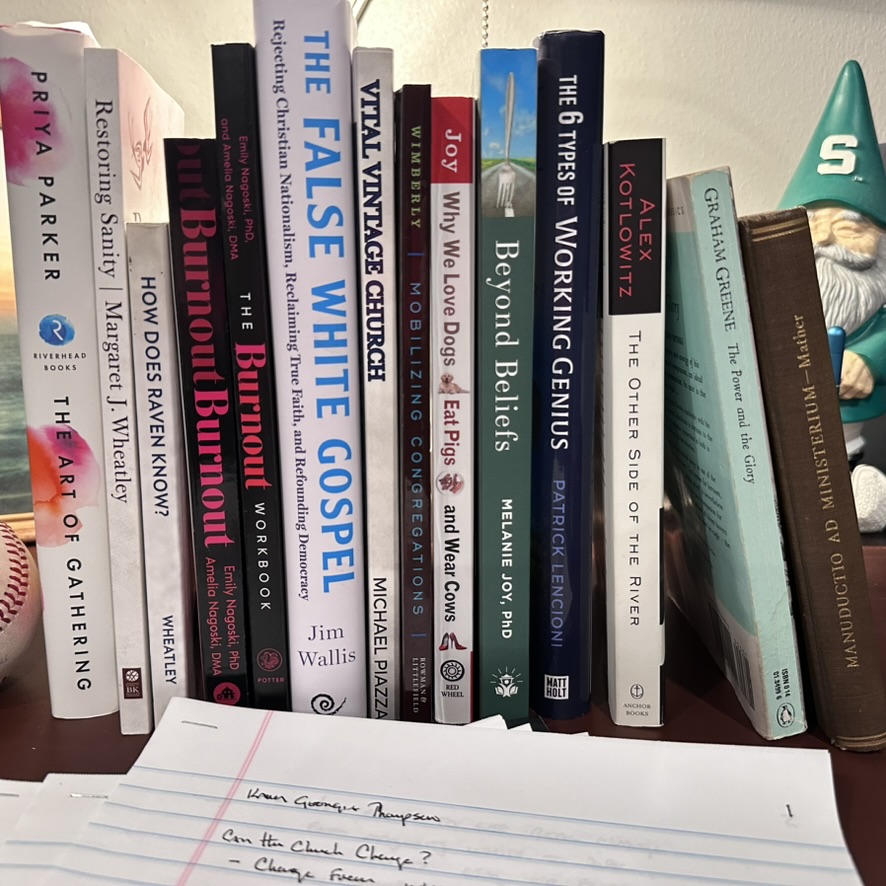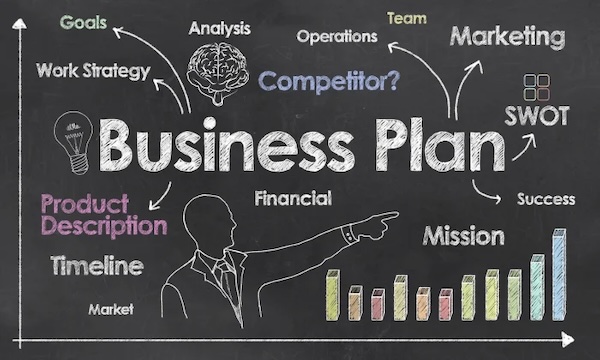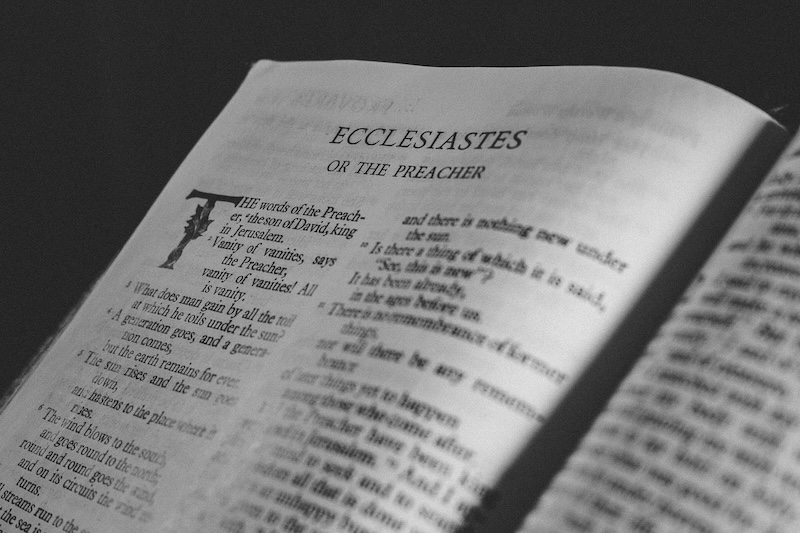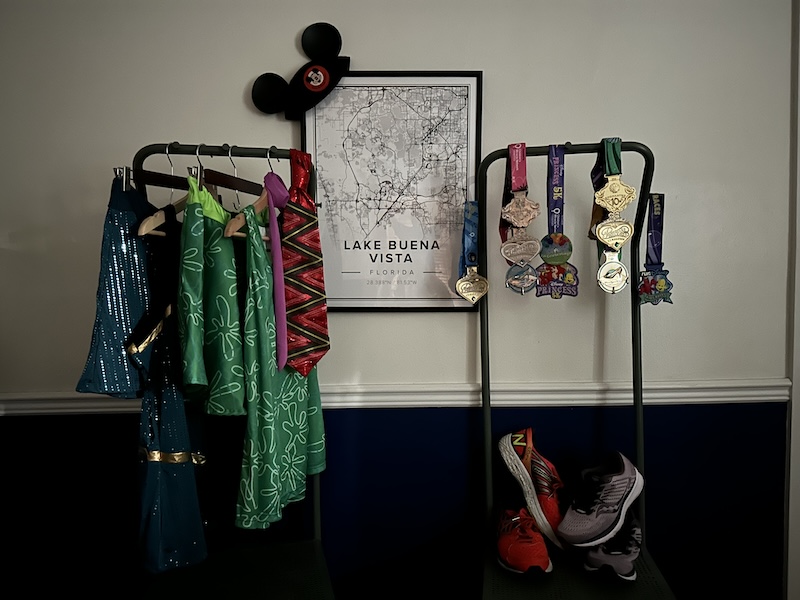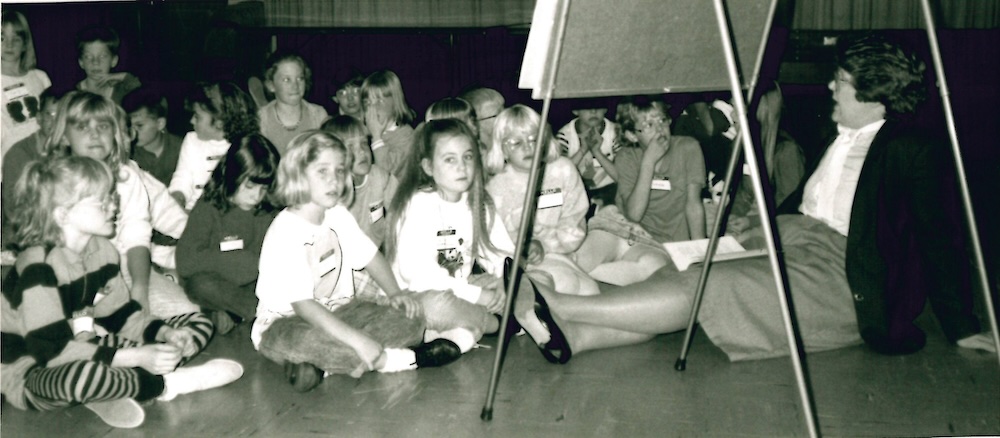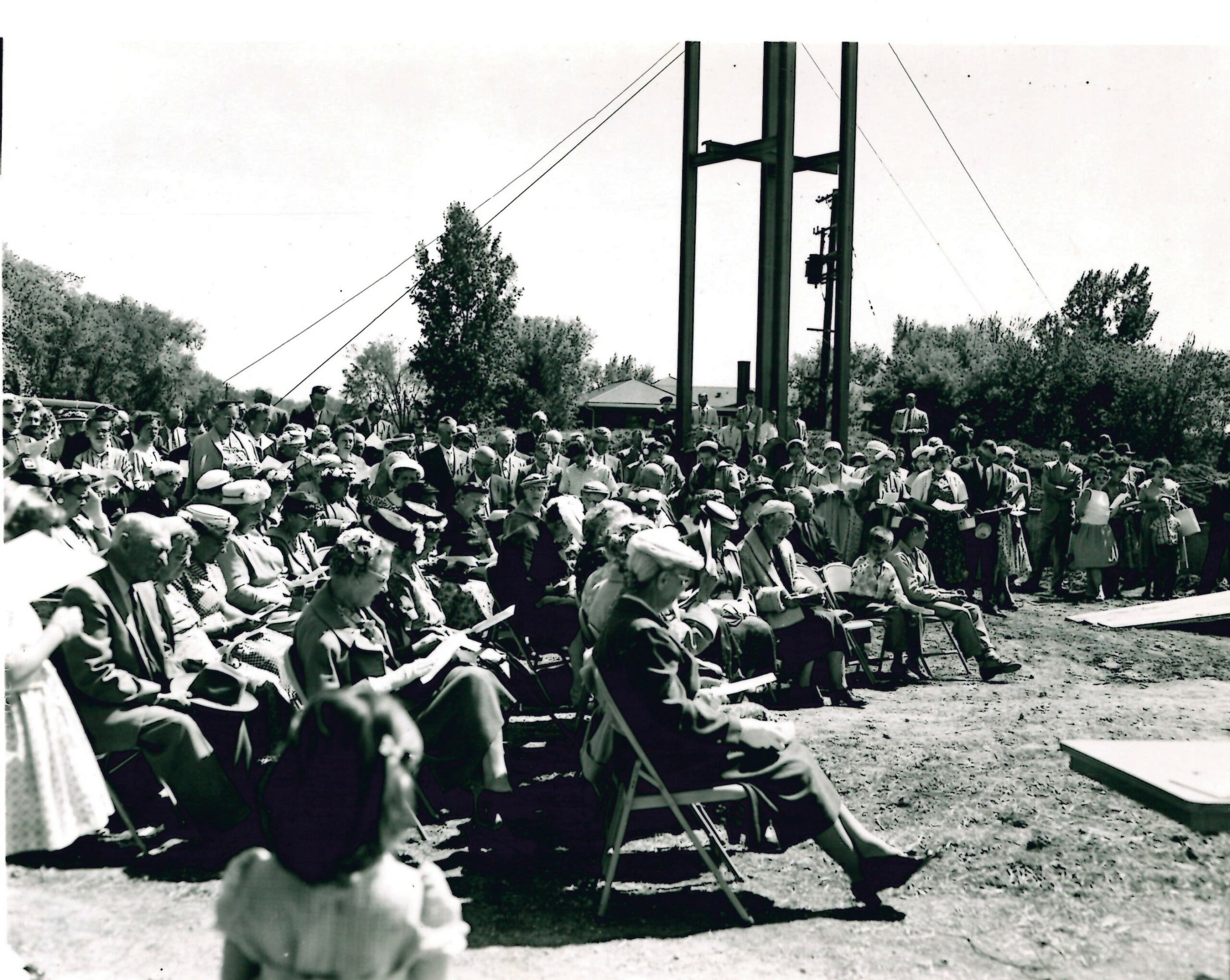One of the central parts of my Sabbatical renewal was to get back into reading: reading for growth and reading for pleasure. So, like so many of us did in our school days, I present you with “The Book Report,” a click through of the thirteen books with which I spent my time.
If you can visualize my desk in my church office, you’ll see a pile of “TBR” books… okay maybe three piles. One would be for the practical side of church life (engaging membership, visioning ministry, etc); one for worship and spirituality (how to design worship, how to engage multiple generations, sacred music & story, etc); and one for business (Values/Vision/Mission, staff & volunteer management, and practical stuff). In the busy-ness of the week, I find at least an hour a day to step out of work and step into develop some part of the “professional” me.
Reading for pleasure during the “church year” is always more difficult. It’s often the last thing I do in the evening, and often relegated to bed time. And that last thirty minutes of being awake may provide sleep, but hardly the pleasure. More often than not, if I was into the story I’d stay up too late. While the reading was fun, the next day not so much.
For the sabbatical, I set up these “rules to read by:”
- Read the books. Really read them. Skim if needed, but then dive deep.
- For every hour of professional development, read an hour of pleasure reading.
- Rotate between reading for development and reading for pleasure. Balance the “right side” and the “left side” renewal.
- If taking notes on one book, take time to journal on another
- If you fall asleep, stop reading. There will time later to read more.
Maybe they can be a help for you, too!
If you want to get a copy for yourself, there is a link at the bottom of each book’s review. They’ll direct you to one of our “local-ish” independent books shops, Anderson’s Bookshop in Naperville, IL. (Love you all!)
So, with a grand drumroll…. Let’s start reading!
The Church Life Books
These books come to the list in the spirit of the sabbatical theme, “Enter to Worship / Depart to Serve.” Jim Wallis is a sage of the intersection of faith and public life. Emily Nagoski and Amelia Nagoski are stewards of our mental and emotional center. Michael Piazza is a caretaker of congregational story, life, and ministry. John Wimberly gets us into the practical parts of life in community.I
I hope you are as inspired by these books as I. They were great companions in my renewal, retooling, and refocusing on my call to follow in Christ’s Way.
The False White Gospel – Jim Wallis
“I believe that white Christian nationalism is the single greatest threat to democracy in America and to the integrity of the Christian witness…”
-Jim Wallis, The False White Gospel
» Click here for the whole story
I have respected Jim Wallis’ scholarship and wisdom for years. His “long-view” on faith and politics is unmatched. His dissection of the political co-option of the label of “Christian” is unmatched. From the jacket text: “It is time says Jim Wallis, to call out genuine faith―specifically the ‘Christian’ in White Christian Nationalism―inviting all who can be persuaded to reject and help dismantle a false gospel that propagates white supremacy and autocracy. “
I held this book for my last Sabbatical read. On purpose. It’s timely text, opens up the current state of religion and politics; the 2024 elections; and the reality of Project 2025 (which is already affecting the American and global society) for all to see. “If they have eyes…” to quote a wise Rabbi.
“I believe in the separation of church and state, absolutely. But I don’t believe in the separation of public life from our values, our basic values, and for many of us, our religious values”
-Jim Wallis, Frontline/PBS Interview
FWIW: If you’ve red Jim’s previous books (God’s Politics,etc), you might find a story that you’ve heard before. Bear with it. There is Spirit-led insight that is necessary for November 2024 and beyond.
» Click here to get a copy for yourself
BURNOUT / The BURNOUT Book (workbook) – Emily Nagoski & Amelia Nagoski
“Burnout is for women (or anyone) who has felt overwhelmed and exhausted by everything they have to do, yet still worried they weren’t doing ‘enough.’”
-from BURNOUT’s website
» Click here for the whole story
Yes, you need to read this book. It’s for “anyone” and everyone, to be sure. I read the Nagoski’s book during my first week of Sabbatical (while sitting at a laundromat, scheduling a family vacation, dealing with a car repair, while the internet and power were knocked out during a spring storm. And I laughed, and laughed, and laughed! Time to break the BURNOUT cycle, eh?
Writing together, sisters Emily and Amelia Nagoski open up the real-life “biological stress cycle,” and how our brains regulate the emotion of frustration (and all of its niggling attachments). They share sympathetic stories, combined with physiology, bolstered by practical techniques. In the end, their goal is supported and well-told, that “wellness, true wellness, is within our reach.”
And the workbook! What a blessing! Reflection space and journaling, all taking your reading to the next level. Again, it’s geared for their target audience. So if you’re still struggling with the intersectionality of patriarchy, get ready to break that cycle, too. If you’re willing, it’s easy to see the “everyone” in their welcoming eyes.
“To be ‘well’ is not to live in a state of perpetual safety and calm, but to move fluidly from a state of adversity, risk, adventure, or excitement, back to safety and calm, and out again. Stress is not bad for you; being stuck is bad for you.”
FWIW: Yes, there is a fair bit of the “usual self-help” materials. The Nagoskis take the time to contextualize it for today, and make you feel like you’re in a safe place to hear/feel/scream about life, the universe and everything. So feel your feels, and read the book.
» Click here to get a copy of the book; and Click here for the workbook
Vital Vintage Church – Michael Piazza
“No, the mainline church will not return to its glory days of the 1950s and ’60s, nor should it. What we must do is unleash the amazing life-giving power of grace, forgiveness, restoration, community, devotion, hope, purpose, and meaning that has always been the mission of the church.”
-Mike Piazza, Vital Vintage Church
» Click here for the whole story
Mike’s dive into thriving congregations is a great journey. With the ever-present “demise of the mainline” echoing in the “trade media” for churches, I appreciate his one-two punch of purpose and direction (and his use of metanoia for a apt description for “change”). He sets out a practical, yet personal, tale of the stories of churches that honor their traditions, hold on to their values, and understand the vision that God is casting before them.
“The real test of your resovle to offer a radical welcome is to answer, ruthlessly and honestly, this question: ‘For whom is your worship designed?’ Does it serve the needs of those who attend already, or is it carefully crafted so that guests have an optimal experience?
“To ask that another way, is the congergation oriented to be the Body of Christ… or do they see themselves as the consumers of church?”
-Mike Piazza, Vital Vintage Church
FWIW: This is a pre-pandemic book, and its impact does cast a shadow. Piazza hasn’t written on it specifically, but the wisdom to “change the narrative of doom and gloom” and “ take a breath, take the plunge” in discovering that our origins and traditions can open our eyes to the fullness of today’s ministry.
» Click here to get a copy for yourself
Mobilizing Congregations – John W. Wimberly
“When twenty-first-century people are given autonomy, empowered to master their work, and linked to visionary purposes, they are highly motivated and more likely to accomplish their goals. While the effort of volunteers in a congregation aren’t work perse, theur efforts are the work of the church.”
-John Wimberly, Mobilizing Congregations
» Click here for the whole story
John’s thesis is easy to hear: Teams > Committees. Focusing on individuals passions and gifts, and embracing the implementation of vision/mission/values as a journey without limits, he sets out a roadmap for the Post-Boom church. This echoes Disney Institutes’ wisdom on clear outcomes with individual autonomy: If you give folks clear roles and enough room, they will bring success beyond the expectation of the planners. And they’ll own it as their own!
“Of all the changes that took place as our congregation went through this transformation, one of the most important was them movement from committees to teams. “
-John Wimberly, Mobilizing Congregations
FWIW: Wimberly’s book is great for a church already in transformation. It may come across as a bit generationally-biased for those who embrace “Committee Culture.” I see it as a great eye-opener for congregations working on vitality within older organizational frameworks (or more traditional thinkers).
» Click here to get a copy for yourself
The Book Report: The Worship & Spirituality Books
I want to recommend to you two amazing Wise Ones: Margaret Wheatley and Melanie Joy.
I first met Wheatley’s wisdom in seminary, addressing the importance of engaged leadership and the need for community and communication. She continues her thoughtful sociology, helping us find ways to authentically connect and reflect on living together.
I encountered Joy’s writings at the UCC’s General Synod 34 in Indianapolis. I had the privilege of chairing a resolution committee on “Towards a Plant-Based Life.” IYKYK, the resolution wasn’t successful. But it did inspire me to a year-long journey of plant-based eating, and compassionately witnessing what living plant based looks like in meat-eating/meat-loving world. (FYI- Check out my Projects page for some awesome recipes!)
Restoring Sanity – Margaret Wheatley
“Sane leadership is the unshakeable faith in people’s capacity to be generous, creative and kind. It is the commitment to create the conditions for these capacities to blossom, protected from the external environment. It is the deep knowing that, even in the most dire circumstances, more becomes possible as people engage together with compassion and discernment, self-determining their way forward.
– Margaret Wheatley, Restoring Sanity
» Click here for the whole story
Meg gives us a gift (she usually does!), but this time she lets us know that at the beginning. “Gifts are mean to delight and surprise,” she tells us. And this book of practices and reflections was a great gift for my sabbatical. I found it when looking for something else, and rejoiced in its contents from the first break of its spine. It became my morning devotional companion (and was specially grounding when I was watching hours of ‘un-human’ asynchronous video learning modules).
Identity, certainty, generosity, creativity, kindness – she reminds us that this is what it means to be human. And Wheatley challenges us to go beyond the knowable, and embrace the mysterious:
“Can we trust the stories we’ve heard and the experiences we’ve had that will never be explained by petty scientific explanation?
“What’s your experience of sensing, knowing things ahead of time, intuition, knowing when to contact someone? What experiences have you had where the most elegant solution – the simplest – is to give credit to forces, energies, beings beyond the physical realm?
“What does it mean to be human? Are we more than our physical selves? What gives life meaning? The simplest way to answer these questions is to understand ourselves.
-Margaret Wheatley, Restoring Sanity
FWIW: Just read it. A couple of times. And then put it down for a week, and flip through it again. On one level, you’ll find yourself. And on a second, Wheatley’s wisdom in organizational connections will burst through. And when it’s time, open the practices with your workplace, church, book club… whatever group you’re part of that needs to be awakened anew!
» Click here to get a copy for yourself
How Does the Raven Know? – Margaret Wheatley
“The power of ravens to console, with their presence, has astonished me into a world, that is not new, only forgotten, lost in separation and domination, as now we sit in ravaged relationship, with the living world.
“It was never this way, in any other time, with any other people, a world focused only on us, full of manipulation, creating extremes of, isolation, loneliness, grief, terror.
“We are driving ourselves crazy.
– Margaret Wheatley, How Does the Raven Know? (punctuation added to indicate poetic verse)
» Click here for the whole story
I got my copy of Raven second-hand from a Goodwill store off eBay. TBH, it was grungy. It was covered in a fine black silt, that I quickly realized was mildew. And I laughed. Because, if you know the stories of the natives of the Pacific Northwest Coast of the United States and Canada about Raven, they were always a mischief maker. Raven is a trickster.
Wheatley gives us gifts of quotes and poems to bring us in to that “trickiness.” She subtitled her book “Entering Sacred World | a meditative memoir.” Bringing the wisdom of different traditions, she tricks us into thinking about what we need to think about (even when we’re not ready to think about it!).
“We are told how wrong it is to impute, our intelligence to animals, building them up raising their ranking, attributing behaviors meant only for us.
“But what if we were as intelligent as animals?
“…We are a young species, we would be wiser if we recognized our immaturity, and used our intelligence, to take our right place on the planet.
– Margaret Wheatley, How Does the Raven Know? (punctuation added to indicate poetic verse)
FWIW: My love for the Raven stories brought me to read this book. But it’s not a retelling of Raven’s saga. Instead, Wheatley’s real trick is telling us that it’s okay to grieve what we have lost, and to reach out for support, encouragement, and consolation from the creation that has knit us into being. It’s going to take you some time to read through this. So don’t rush yourself. Embrace the world into which we are borne, and listen. In time, Raven will speak their truths for you, too.
» Click here to get a copy for yourself from ThriftBooks
Beyond Beliefs – Melanie Joy
Dear Non-Vegan,
Chances are you’re reading this letter because there’s a vegan (or vegaterian) in your live who wants to feel more connected with you. Maybe you’ve been having trouble communicating with each other…
In all kinds of relationships – not only between a vegan and someone who’s not vegan – the key to feeling more connected (and being happier overall) is being able to “compassionately witness” each other.
Connection is only possible when we know and appreciate what the world looks like through each other’s eyes, and when we can trust that the other will do their best to take our feelings into account when they say or do things that may impact us.”
– Melanie Joy, Beyond Beliefs, excerpt from ‘Appendix 9: Letter to a Non-Vegan’
» Click here for the whole story
Her subtitle says it all: ” A guide to improving relationships and communications for vegans, vegetarians, and meat eaters.” With a picture of a literal fork in the road, Joy’s challenge is pretty straightforward. Stop judging. Start listening. And ultimately, realize that we all live in the same world.
Beyond Beliefs is as much a “relationship book” as it is a challenge to embrace plant-based or plan-exclusive diets. Joy outlines well the struggle that comes when people belittle one another’s diet choices as “fads” or the like. I think this text could be equally as inspirational in couples counseling as the Gottman Institute’s work in relationship dynamics. And (tongue in cheek), this method comes with amazing cuisine!
» Click here to get a copy for yourself
Why We Love Dogs, Eat Pigs, and Wear Cows – Melanie Joy
“Bearing witness takes the courage to realize the potential of the human spirit. Witnessing requires us to call forth the highest qualities of our species, qualities such as conviction, integrity, empathy, and compassion. It is easier by far to retain the attributes of carnistic culture: apathy, complacency, self-interest, and “blissful” ignorance. I wrote this book––itself an act of witnessing––because I believe that, as humans, we have a fundamental desire to strive to become our best selves.”
– Melanie Joy, from Why We Love Dogs, Eat Pigs, and Wear Cows
» Click here for the whole story
“Carnism” is a harsh word. Etymologically, Meat-thinking doesn’t sound appetizing. And that’s just what Melanie Joy is trying to tell you. She challenges us to stop thinking “about the way things are,” and ask ourselves why one species becomes beloved and the other becomes, well, dinner.
Too harsh a distinction? Well, try this:
In much of the industrialized world, we eat animals not because we have to; we eat animals because we choose to. We don’t need to eat animals to survive or even to be healthy; millions of healthy and long-lived vegans have proven this point. We eat animals simply because it’s what we’ve always done, and because we like the way they taste. Most of us eat animals because it’s just the way things are.
– Melanie Joy, from Why We Love Dogs, Eat Pigs, and Wear Cows
So here’s the challenge: Read the book, and open yourself to a different ideology about the food we eat, and where it comes from. Maybe you’ll find some of the facts “distasteful”or dismissive of your ideology. Other parts you may find “palatable” for change.
» Click here to get a copy for yourself
FWIW: Both Beyond Beliefs and Dogs/Pigs/Cows give you an entry point to the psychology, ethics and impact of living a meat-centered/Carnistic life does in our worldviews. I’m not saying that you need to change your diet (well, yes, we probably all do…). But I would encourage you to be open to seeing how your dietary choices affects your relationships with others, and with yourself.
The Book Report: The Business Books
The Art of Gathering – Priya Parker
“Barack Obama’s aunt once told him, ‘If everyone is family, no one is family.’ It is blood that makes a tribe, a border that makes a nation. The same is true of gatherings. So here is a corollary to his aunt’s saying: If everyone is invited, no one is invited—in the sense of being truly held by the group. By closing the door, you create the room.”
– Priya Parker, The Art of Gathering: How We Meet and Why It Matters
» Click here for the whole story
This I believe: We’ve forgotten how to gather as community. COVID is partly to blame. But this part of us was broken long beforehand. Parker’s challenge, “The way we gather matters.” should sink into us deeply.
The Obama family quote is equally as striking. If everyone is in, then no one is in. We lose ourselves in some bland falsehood that “They know us. And we know them.” Yet, as survey after survey tells us: we are all feeling alone. Heck, Gallup tells us that a quarter of us feel “Very Alone,” and another quarter, “A Little Lonely.” That’s half of us, y’all… and we’re not talking about it.
Parker uses her eight chapters to teach us about different kinds of gatherings, with different purposes and outcomes. The one that lives in my heart – that I think we need the most is Chapter Seven’s: Cause Good Controversy.
My belief is that controversy – of the right kind, and in the hands of a good host – can add both energy and life to your gatherings as well as be clarifying. It can help you use gathering to answer big questions: what you want to do, what you stand for, who you are. Good controversy can make a gathering matter…
– Priya Parker, The Art of Gathering: How We Meet and Why It Matters
FWIW: It’s okay to be alone, and to feel lonely. I’m not going to demand you change that part of you. But I’m going to take Parker’s transformative witness to heart – at work, and at church, and at home, and at all of the other places where we find ourselves in community.
» Click here to get a copy for yourself
The 6 Types of Working Genius – Patrick Lencioni
“When I was a young child, I remember my dad frequently coming home at night frustrated by something he called work. And though I didn’t really understand what work was, this really bothered me and I felt bad for him.
“It wasn’t until I started working myself that I learned that jobs were often a source of frustration for people, and that the causes of this included bad managers, poor company leadership, broken relationships with colleagues, and people having to do jobs that didn’t match their natural talents and gifts…”
– Patrick Lencioni, The 6 Types of Working Genius
» Click here for the whole story
I said this back in the “Mouse/Church” series: I do love the organizational management of Patrick Lencioni, and have used his work in managing the business aspects of congregational life fro many years (Death by Meeting being a favorite!).
We’re working with this assessment as a staff team now. Specifically, we’re honing our “genius” in debriefing and actualizing the Sabbatical’s outcomes (and there’s a lot to talk through!). After opening the book and working through the inventory, it’s out task to center around the gifts God has woven into our team. Here’s the questions we’re working through:
- 1. Where in your current role are you experiencing fulfillment? Frustration?
- 2. Are there ways we can better use our team member’s geniuses?
Ultimately, we’ll be rolling a version of this out to the congregation’s Leadership Teams, too. Because, as Pat says:
“If you want to be successful and fulfilled in your work, you must tap into your gifts. That can’t happen if you don’t know what those gifts are.”
– Patrick Lencioni, 6 Types of Working Genius
FWIW: This isn’t the place most folks should start with the Table Group and Pat’s wisdom. I find that most organizations focus on their VMV statements (or SMART Goals outcomes) that their organizational parts are unbound to their values. I’d point to The Five Dysfunctions of a Team or The Truth About Employee Engagement (originally published as The Three Signs of a Miserable Job) as better starting points. I will say this: you’ll still end up at Working Genius, but you’ll be better prepared for it!
» Click here to get a copy for yourself
The Book Report: The Pleasure Reading Books
These books are re-reads, each coming from a different part of my life, my growth and my understanding of my calling (even if I didn’t know it yet!). I first read journalist Alex Kotlowitz’ There are No Children Here in my first year at seminary. Graham Greene‘s travelogue-style was a gift from my high school AP Literature course. And the ever-preachy Rev. Cotton Mather entered as a gift from my grandfather’s library.
They each hold a special place in my heart and spirit, and on my bookshelf.
The Other Side of the River – Alex Kotlowitz
The events surrounding Eric’s death should ring familiar to all of us, both black and white: the confusion and the understanding, the despair and the hope, the disconnections and, indeed, the connections. With all that in mind, I set out to find out how Eric ended up in what is the towns’ strongest connection of all, the river.
– Alex Kotlowitz, The Other Side of the River
» Click here for the whole story
Kotlowitz’ tale of Benton Harbor and St. Joseph, MI is a tale of familiarities. While his story wraps itself around the two towns, we jut need to look out of our windows to find comparable tales of White Supremacy, of Race and Racism, of generational injustice in the name of “progress.” And Kotlowitz’ subject matter – the unexplained death of an African-American youth in a super-majority White town – is equally comparable to so many (so… many…) stories we find in our news today.
This was the last text that I picked up during my Sabbatical. And I almost didn’t. Its story is raw for me, though I came to it second-hand. And, it’s also the last review I’m writing. Because, as I share later, it hits me close to home.
What makes it personal was two-fold.
First, I lived there. I lived on Marina Drive in St. Joseph, on the Benton Harbor-side, just down the river from where Eric McGinnis’ body was found. From 2002-2006, I shared in the ministry at First Congregational Church UCC – St. Joseph, MI. I knew the people in the book, some through social or ministry connections; some because they worshipped with me on Sundays. I knew this town from the White side, while building relationships across the river. And I can witness that the ten years since Eric’s death had not tempered the divide between the sibling cities… not at all.
My copy of the book was given to me by a former mayor of St. Joseph when I arrived as an introduction to the city (and it’s twin across the river). I read it cover to cover over the next couple of days, and then found myself (map in hand) seeing the two cities through the book’s lens.
Second, Eric and I would be the same age today, had his life not ended on May 17, 1991. He was born just about two months before me. While I was living in Cincinnati, and he in Benton Harbor, we grew up in the same social realities. We both saw a world uncomfortable with race, and tied to generations-old hate. I like to think from what I’ve read about him in this book and other places, that had we met we could have spoken about the reality of life growing up in the early 1990s. And maybe we would have shared what we’ve witnessed in our years since 1991 of Race and Hate in America, of White Privilege, and too many stories of too many deaths motivated by these to catalogue.
I started reading this book while on a family vacation on Lake Michigan in August, 2024. In the sand near Warren Dunes State Park, on a blustery wave-filled Wednesday, I opened it again. Fifteen miles of beach and cliff separated me from the St. Joseph River, and thirty-three years.
As I said, this was the last book of the Sabbatical. And I can truly say, I’m sad I did. I’m glad I did.
FWIW: Read it, please. See what Eric’s story tells us about our world today.
» Click here to get a copy for yourself
The Power and the Glory – Graham Greene
‘Oh,’ the priest said, ‘that’s another thing altogether – God is love. I don’t say the heart doesn’t feel a taste of it, but what a taste. The smallest glass of love mixed with a pint pot of ditch-water. We wouldn’t recognize that love. It might even look like hate. It would be enough to scare us – God’s love. It set fire to a bush in the desert, didn’t it, and smashed open graves and set the dead walking in the dark. Oh, a man like me would run a mile to get away if he felt that love around.’
– Graham Greene, The Power and the Glory
» Click here for the whole story
I have Mrs. Ria Hursting to thank for this one. She was my AP- English Literature teacher. Along with Conrad’s Heart of Darkness, I had the “joy” of reading Greene’s masterpiece over the summer between my Junior and Senior year. And I hated it.
Then, as others asking telling me, “What about ministry?”, I found an abused Penguin Classic edition of The Power and the Glory, and it sunk into me anew. I met the main character, the ‘Whiskey Priest,’ as an adult. This one, like me, who always sought to do the right thing, lived a story out loud for us all. And his commitment to seeing it out, “too human for heroism, too humble for martyrdom,” is an understated encounter of being human while following in Christ’s Way.
“He knew now that at the end there was only one thing that counted – to be a saint.”
– Graham Greene, The Power and the Glory
FWIW: It’s a quick read. And maybe you will find yourself in the pages, as I did. Maybe not. Maybe you’ll just look for the ticket out, like Mr. Tench. But you’ll have to read it all to find out!
» Click here to get a copy for yourself
Manductio ad Ministerium (1762, original text)- Cotton Mather
“CHRISTIAN, Fill thy Life with ‘most explicit Acknowledgements of the Glorious God, and Acts of Obedience to Him. Let even ‘the whople business of they Temporal Calling be explicitly designed for an Obedience to GOD. At the same time, Fill thy LIfe with Good Offices to Mankind, and with Actions that shall be Blessings (and make the Doer a Rich One) unto thry Neighbors.
This will be Living – CAETERA MORTIS ERUNT.
– Cotton Mather, Manductio ad Ministerium (text appears here as printed)
» Click here for the whole story
I received my copy of this book from my grandmother, Edith, when I started seminary. She had kept it on her bookshelf, an editor’s preview given to my grandfather Butler (whose name I and my father were ‘regressively’ given). The flyleaf notes the hope that the reprint may give inspiration to a new generation, first encountering the wisdom of Mather through its reprinting.
When I was questioning my calling, and struggling to articulate my vocation, Mather became my interlocutor, my challenger:
“Intending to give you some DIRECTIONs for your Proceeding in the STUDIES, uponwhich you are Entring, that you may be prepared and furnished for the work of Evangelical MINISTRY, to which you are designed… But the Contemplation of DEATH shall be the first point of Wisdom that my Advice must lead you…
“Do this, that you may do nothing like Living in Vain… I propose a ‘VIVE MEMOR MORTIS” as what wil be the Way to Truest wisdom.
– Cotton Mather, Manductio ad Ministerium (text appears here as printed)
“Living in the Question of Death” Mather challenges, ‘shouldmake you assoon as may be “Begin to Live.”
FWIW: It’s a bit preachy (He’s a Mather…). And he speaks in his own vernacular (pardon the VERY exclusive language!) But if you can get past this aspect of an 18th-century New England Puritan, I believe you’ll find yourself asking yourself deep questions about your life, your faith, and where God is calling you to be and do.
One joy is that this book is available in PDF for computers and for e-readers. So while it’s hard to find a print edition, it’s available for easy access if you use your screens to read. You can also order a bound version:
» Click here to get a copy for yourself
Thanks to you all for being part of the Sabbatical time, and for checking out this book list. I do hope that one (or more!) of these stories ends up on your reading list. Books are, at their heart, places for us to journey; places for us to find renewal and rest. Books are the stuff Sabbaticals are made to prayerfully ponder.
Also, check out the posts on my experience with Disney Institutes: Of Mouse and Church.
May you find your Sabbatical story, be it here or in your TBR pile!
And now that my renewal time is done, I can say this again:
I’ll see you in church real soon!
-HEF

